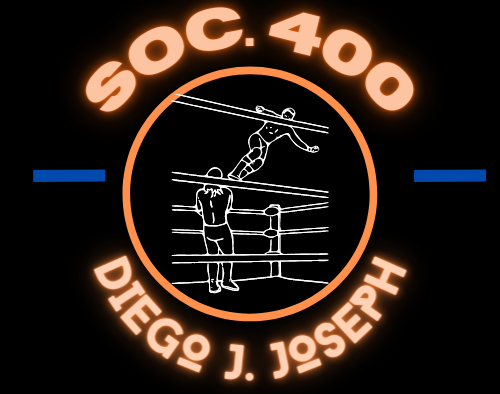This initial theme of attire and racial stereotypes was developed by watching the wrestlers’ entrances and each of the wrestler’s attires in and out of their matches in the ring. As I was coding for the quantitative analysis more than half of the wrestlers of colour in every industry carried their cultural flags in their entrances in every segment reviewed and was prominent on their clothing when wrestling.
For instance, the team of wrestlers known as Santana and Ortiz (2019) working for All Elite Wrestling wore and continue to wear the Puerto Rican flag in their attire whether it be across the heads as a bandana or tied around the lower portion of their body for both their entrance and while they are wrestling (Khan 2019). These flags although represent wear they come from, also associate certain behaviors that influenced how the audiences may see them. Although, important for representation these flags are accompanied by stereotypes that these wrestlers were thugs and gangsters while also being a wrestler.
Cultural representations with wrestlers did not stop at simply wearing their flags as bandanas but went beyond. Some of these cultural representations have also been shown to be inaccurate in professional wrestling. For instance, Kofi Kingston, a Ghanian born wrestler who was originally characterized as Jamaican (2008) in his debut and first few years working for World Wrestling Entertainment wore a Jamaican tracksuit with the Jamaican colours plastered over his wrestling gear despite being born in Ghana and raised in the United States (McMahon 2008). This acts as a form of cultural appropriation and misrepresentation of culture for wrestlers of colour and furthers stereotypes on not just wrestlers wearing these flags but on the cultures that they are acting to be from.
In addition to the cultural flags, the stereotypes of African American thugs were reinforced through some of these wrestlers’ attire as well. Cryme Tyme, two African American wrestlers who worked as a team (2006) wore timberlands, grills in their teeth, long chains, bullet hole designed jeans, snapback hats, and bulletproof vests from their debut on Monday Night Raw to the end of their time as a tag team in 2010. The team were constantly wearing this in every appearance they had even furthered the stereotypes by not just what they wore to the ring and in their matches, but how they wore it as well. In every episode that was reviewed the team had their clothes torn up or barely on them as they would walk to the ring. Along with adding durags and even larger chains as their career would continue in the company similar to Santana and Ortiz would also have the thug stereotype with their attire as they would repeatedly be called that by other wrestlers and were featured in spray painting property of other wrestlers and scheming to steal money from wrestlers and random people backstage.
Some of the examples that were particularly interesting in my opinion involved two Black identifying wrestlers, we can see the visuals below:
Thinglink created for Cryme Tyme 2022: Cryme Tyme June 2nd 2008″ by RajOMac under CC BY SA 3.0
In under to see if these findings were consistent, I decided to compare the attire of these wrestlers listed above, to white identifying wrestler. Cody Rhodes, a white identifying second generation wrestler (2019) were always seen wearing 5-piece expensive suits compared to wrestlers of colour on the roster. In addition to that, his attire as an American was prominent in everything that he wears including wearing American flags and eagles in his attire when he is not wearing his expensive suits. Compared to the two teams above, his attire is almost pristine and there was a subtle way in creating his wrestling gear, instead of having just the Puerto Rican flag or Jamaican flag he would integrate American flag colours in his own image, creating his own take on America using his logos.
The content analysis conducted throughout the research it became obvious that the wrestler’s clothing was specifically telling narratives themselves. How we as the audience viewed it at the time may have been nothing more than clothes but it represents their overall story and character.
The image above showcases how cultural flags will be represented by wrestlers of colour who may not actually represent these cultures (e.g. Kofi Kingston). Above Kofi is shown wearing attire when he was characterized as a Jamaican islander in 2008 and then as a member of his faction The New Day, a more colorful group of wrestlers that put little to any focus on Kofi’s previous character as the “Jamaican Sensation”
